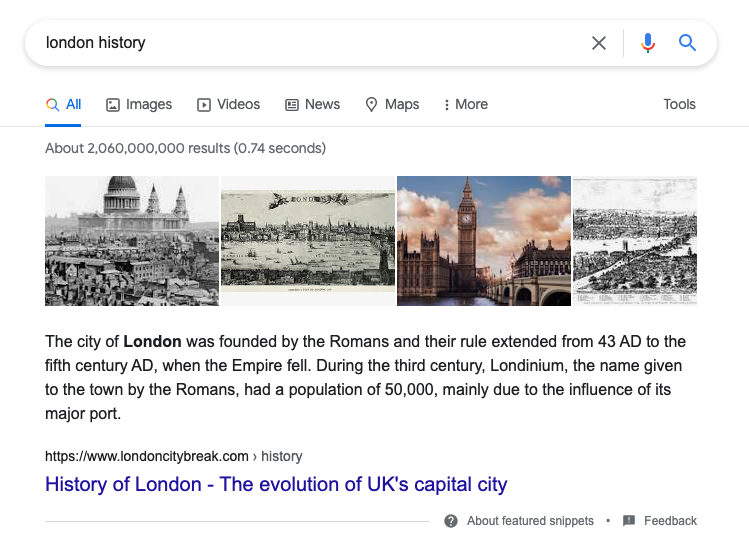
Featured Snippets: What, Why, and How?
Is your content optimised to appear in the featured snippets? Well if not, there could be no better time to get started than now. Having content featuring here can boost your website authority and credibility significantly. Users are more confident to click sites that appear on Featured Snippets, which is beneficial to your SEO strategy.
Apart from increasing site reputation, Featured Snippets also ensure that webpages are encouraging different types of searches including the new voice-activated online searches. With technology becoming more versatile, this search engine feature is becoming indispensable as people switch to newer methods of searching content on the web.
So how do you optimize content to appear on featured snippets? Before we delve into the details of content optimization, it is imperative to understand what featured snippets are and their significance to any website owner.
What are Featured Snippets?
Featured snippets refer to the sections of a webpage displayed directly on search engines results pages. Google’s commitment to providing users with relevant content is undeterred and featured snippets are one of the ways of providing such precise information.
When a user enters a query on the search tab, the search engine aims to give precise results straight away. Google, therefore, uses snippets to provide responses that best fit the queries, especially those that answer the query more directly. For instance, if you type the search term “recent cyberattacks”, the search engine will return snippets highlighting the latest cyberattack news across various departments and regions.
On SERPs, the featured snippets appear just below Google AdWords, which places them above organic search results. This placement is referred to as #Position 0.

Types of featured snippets
The snippet displayed on the SERP varies depending on the nature of the user’s query and search engine. It is therefore essential to understand the type of featured snippets that suit your niche or topic to optimize your content appropriately. Here are the different snippets Google uses to present data and present information to users.
Text Snippets
The text snippets can take the form of paragraphs that contain definitions or provide a brief description of containing the search term. Queries that require straightforward responses such as word definitions appear in the definition boxes while those requiring additional information are presented in answer boxes.
List Snippets
A list containing steps of a procedure such as a recipe or ranking of different items can also appear in snippets. The featured snippets list can either be ordered or unordered. A search for “top 5 best plugins” for example, is likely to yield a list type featured snippet.
Table Snippets
For queries that require a comparison of data, table snippets are the most suitable way of displaying content. If you are looking for the comparison of the annual revenue of the world’s largest companies in 2021, for instance, a table snippet is likely to appear.
Video Snippets
Snippets featuring videos from popular platforms such as YouTube are a common thing, especially with the “how-to” search terms.
Regardless of the type, a link to the site from which the content is extracted is always included below the snippet. As snippets appear above the organic search results, it is likely to attract more organic traffic to your site helping you gain a competitive edge.
Why should your content appear on featured snippets?
During a web search, users tend to click on the sites with the most relevant information. Typically, optimising your content for specific keywords ensures your website ranks higher on the search engine result page thereby increasing the organic traffic you receive.
With featured snippets, optimised content is readily displayed on #position0 in the SERPs. For complex queries that require detailed information, users need to click the link to visit external pages. However, simple searches like definitions do not require users to visit a webpage. Such queries that can be answered without the user clicking a link are referred to as ‘no click searches’ and are only plausible with featured snippets.
If your website or business relies on organic traffic, such a change in SERP strategy is likely to have a significant impact on your success. As the number and precision of snippets increase, which is inevitable, the number of users clicking through page links is bound to decline. But the users who will be clicking through links to the webpages are highly likely to click on featured snippets. So your effort should be focused on getting your site onto the featured snippet list.
Again, featured snippets appear more commonly in voice search results which is currently on the rise. Optimizing your content for voice-activated searches and Google snippets ensures that your site remains updated in the search index ready to appear whenever a related keyword search is entered. These snippets will help you establish your site’s credibility and gain a competitive advantage in your niche.
How to optimize your content for featured snippets
Google displays only a single snippet for every search term. Appearing on the featured snippet, therefore, means your content must be highly rated by the search engine bots. Below are some strategies for increasing the likelihood of your content being spotted by Google and presented in the snippets.
- Employ effective SEO strategy
The snippets displayed by Google are primarily drawn from the first 10 web pages on SERPs. Employing an effective SEO strategy will help you boost your site’s ranking and increase the chances of your content being featured on the snippets.
- Tweak your content
Not every query returns results with snippets. Noteworthy, some search terms are more likely to give results with featured snippets than others. For example, keywords such as recipes, costs, numbers, best, meaning, and price almost always yield snippet results. Modifying your On Page SEO content to include some of such popular terms naturally; enhances your site’s probability of appearing on the featured snippets.
- Diversify your content format
Snippets can take the form of lists, videos, images, tables, or paragraphs. To ensure your site appears as a featured snippet, it is necessary to organise your content in one or more of these formats. However, the layout should be relevant to your content presentation.
Conclusion
The featured snippet is an important part of the Google search engine’s results page. It appears at the top and can be seen as a quick answer to your question or as a direct link to more detailed content on the subject from another site. To get one for yourself, you need to know what it takes and understand how people use them when they appear in their searches. If you have any questions about getting featured snippets, please let me know!
